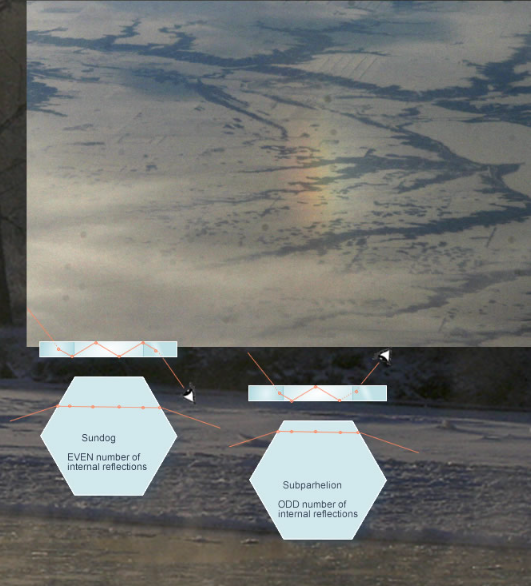Odd and Even
Odd and Even: Unraveling the Mysteries of Atmospheric Optics
Have you ever marveled at the strange and captivating optical phenomena that occasionally grace our skies? From dazzling rainbows to shimmering halos, the atmosphere holds a myriad of enchanting secrets. One such phenomenon that has intrigued scientists and skygazers alike is the occurrence of odd and even reflections in the form of sundogs and sub-parhelia.
Sundogs, also known as parhelia, are luminous spots that appear on either side of the sun, forming a stunning display of light. These ethereal companions are born on bitterly cold days when diamond dust crystals fill the air. These crystals, which originate from moisture in nearby bodies of water, play a crucial role in the formation of sundogs.
The intricate dance of light begins as rays pass between the side faces of plate crystals that are inclined at a 60-degree angle to one another. When the sun hovers near the horizon, most rays traverse the crystal without deviation. However, as the sun ascends higher in the sky, an increasing number of rays reflect internally between the large upper and lower faces of the crystal.
Here's where things get interesting: rays that reflect an even number of times, or not at all, give birth to the glorious sundogs we so adore. These rays create a symmetrical pattern of light on either side of the sun, painting the sky with a vivid display of colors. The evenness of the reflections contributes to the distinct shape and appearance of sundogs.
But what about their enigmatic counterparts, the sub-parhelia? These elusive phenomena occur below the horizon and exhibit an otherworldly beauty. While flying over winter prairie river terrain, observers have reported witnessing sub-parhelia alongside intermittent subsuns for hours on end. What causes these captivating displays?
The answer lies in the number of times rays reflect within the crystal. Unlike sundogs, sub-parhelia are formed by rays that reflect an odd number of times. This peculiarity in reflection gives rise to the sub-parhelia's distinct characteristics. With intriguing signs of lower tangent arcs and often sub-sun dogs, sub-parhelia offer a unique and mesmerizing spectacle for those fortunate enough to witness them.
To fully appreciate the wonders of odd and even reflections, it's essential to understand the underlying science behind these phenomena. The interplay between light and ice crystals in the atmosphere creates a visual symphony that delights our senses. By unraveling the secrets of atmospheric optics, we gain a deeper appreciation for the complexities of our natural world.
In conclusion, sundogs and sub-parhelia represent two sides of the same coin in the realm of atmospheric optics. While sundogs grace our skies with their vibrant hues and symmetrical patterns, sub-parhelia offer a glimpse into a world of odd and mysterious reflections. The next time you find yourself gazing at the sky, take a moment to ponder the wonders that lie beyond the surface.

22° Plate Halos by Alan Clark of the University of Calgary, Alberta, Canada. ©Alan Clark, shown with permission.
At top is a sundog, a parhelion, formed in very cold weather by diamond dust crystals. The crystals grew from moisture from the nearby Bow River, Calgary.
The lower image is a 'sub-parhelion' pictured over winter prairie river terrain. "While flying from eastern Canada to Calgary on Jan 1, a thin layer of ice crystals produced a subsun for at least 2 hours, sometimes intermittent, but with intriguing signs of lower tangent arcs and often sub-sun dogs .subparhelia.."
The two halos are related.
Sundogs are formed by rays passing between the side faces of plate crystals inclined 60� to one another. When the sun is near the horizon most rays pass straight across the crystal. As the sun climbs more and more rays reflect internally between the large upper and lower faces.
Rays reflected an EVEN number of times (or not at all) form a sundog.
Rays reflected an ODD number of times form a below-horizon sub-parhelion.

Note: this article has been automatically converted from the old site and may not appear as intended. You can find the original article here.
Reference Atmospheric Optics
If you use any of the definitions, information, or data presented on Atmospheric Optics, please copy the link or reference below to properly credit us as the reference source. Thank you!
-
<a href="https://atoptics.co.uk/blog/odd-and-even/">Odd and Even</a>
-
"Odd and Even". Atmospheric Optics. Accessed on November 17, 2024. https://atoptics.co.uk/blog/odd-and-even/.
-
"Odd and Even". Atmospheric Optics, https://atoptics.co.uk/blog/odd-and-even/. Accessed 17 November, 2024
-
Odd and Even. Atmospheric Optics. Retrieved from https://atoptics.co.uk/blog/odd-and-even/.